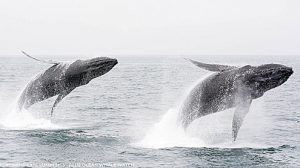By Brandon L. Southall, Ph.D. University of California, Santa Cruz and SEA, Inc.

From the rhythmic ocean metronome of waves to the clicks and moans of animals and from the rumble of underwater earthquakes to the crack of lightning striking the surface, nature fills the sea with sound. Unlike our early perceptions, there is little silence in the ocean.
Animals have made sound under water for millions of years. They use social calls to track their young and compete with one another. Some even use songs to attract mates. Many species use sound as a general means of orientation — knowing where they are going and if predators are around. Some specialized animals, the dolphins and porpoises, have specialized biosonar sounds like bats to focus in on individual prey while they are feeding.
Humans are very much newcomers on the ocean — tens of millions of years behind marine mammals and hundreds of million years after some fish. But we quickly converged on the same realization about the physics of sensing things and communicating information over any real distance. Namely — we use sound to find our way under water. We make sonar pings to know how deep the water is, to find submerged objects, and even as a way to measure the ocean temperature. We can use loud bangs of compressed air to look into the sea floor to study the earth’s crust and image mineral and oil deposits. Finally, we put a lot of sound into the water simply as a by-product of moving big things around — like large ships. How we consider the potential effects of these sounds on the ocean and sea life has evolved from an original simplistic view of how loud they are to a more nuanced view (as in the table below) of their relative pitch, loudness, occurrence, and spatial distribution relative to marine animals and important habitat areas. Sources that may be less loud but very common may have greater potential disturbance on marine life that rare but intense sound sources.
The study of sound in the ocean and how animals use and may be affected by it is an active area of research. A number of field-leading researchers from the University of California, Santa Cruz and partners from around the Monterey Bay and around the world are studying communication systems, developing listening tags and other technologies, and using experimental methods to unravel these complex questions. Improvements in data collection tools and analytical methods are helping scientists look beyond some of the more obvious issues, like the occasional beaching event, to consider how day-to-day human activities can disrupt the natural ocean soundscape. A subsequent article in this series will focus on some of these advances being made by local researchers.
The ocean is teeming with natural sound. Making and listening to sound is critical for marine life. We are increasingly putting noise in the sea. We have just begun to understand whether there are problems and how severe they may be. But we have begun to understand how to better manage these issues — and we have found out a lot about basic biology along the way.